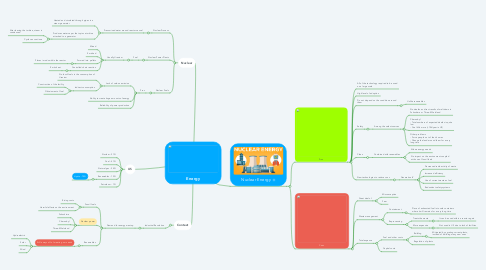
1. US
1.1. Nuclear - 21%
1.2. Coal - 41%
1.3. Natural gas - 24%
1.4. Renewables - 12%
1.4.1. Hydro - 70%
1.5. Petroleum - 1%
2. Context
2.1. Industrial Revolution
2.1.1. Demand for energy went up
2.1.1.1. Fossil fuels
2.1.1.1.1. Rising costs
2.1.1.1.2. Harmful effects on the environment
2.1.1.2. Nuclear power
2.1.1.2.1. Fukushima
2.1.1.2.2. Chernobyl
2.1.1.2.3. Three-Mile Island
2.1.1.3. Renewables
2.1.1.3.1. Still a ways off of meeting our needs
3. Nuclear
3.1. Nuclear Process
3.1.1. Pressurized water around reactor vessel
3.1.1.1. Heated and circulated through pipes in a steam generator
3.1.1.2. Produces water vapor that spins a turbine attached to a generator
3.1.1.2.1. After leaving the turbine, steam is condensed
3.1.1.2.2. Cycle can continue
3.2. Nuclear Power Plants
3.2.1. Fuel
3.2.1.1. Usually Uranium
3.2.1.1.1. Mined
3.2.1.1.2. Enriched
3.2.1.1.3. Formed into pallets
3.2.1.1.4. Controlled chain reaction
3.3. Nuclear Fuels
3.3.1. Pros
3.3.1.1. Lack of carbon emission
3.3.1.1.1. No fossil fuels in the consumption of Uranium
3.3.1.1.2. Indirect consumption
3.3.1.2. Ability to create huge amounts of energy
3.3.1.3. Reliability of power production
4. Nuclear Energy
4.1. Pros
4.1.1. All of the technology required to be used on a large scale
4.1.2. High level of adoption
4.1.3. Do not depend on the condition around them
4.1.3.1. Unlike renewables
4.1.4. Safety
4.1.4.1. Among the safest sources
4.1.4.1.1. No deaths as direct results of meltdown in Fukushima or Three-Mile Island
4.1.4.1.2. Chernobyl - Total numbers of expected deaths is quite low - Coal kills more (>10k/year in US)
4.1.4.1.3. Other problems - Force people out of their homes - Change the land around them for a very long time
4.1.5. Clean
4.1.5.1. Combined with renewables
4.1.5.1.1. Allows energy needs
4.1.5.1.2. No impact on the environment coupled with use of fossil fuels
4.1.6. New technologies to reduce cons
4.1.6.1. Generation IV
4.1.6.1.1. Decreased radioactivity of waste
4.1.6.1.2. Increased efficiency
4.1.6.1.3. Use of current waste as fuel
4.1.6.1.4. Redundant safety systems
4.2. Cons
4.2.1. Great deal of
4.2.1.1. Misconception
4.2.1.2. Fear
4.2.2. Waste management
4.2.2.1. Containment
4.2.2.1.1. Place of exhausted fuel into safe containers where it will remains for a very long time
4.2.2.2. Reprocessing
4.2.2.2.1. Treats the waste
4.2.2.2.2. More expensive
4.2.3. Total expense
4.2.3.1. Fuel and other costs
4.2.3.1.1. Building
4.2.3.1.2. Regulation of plants
4.2.3.2. Capital costs
